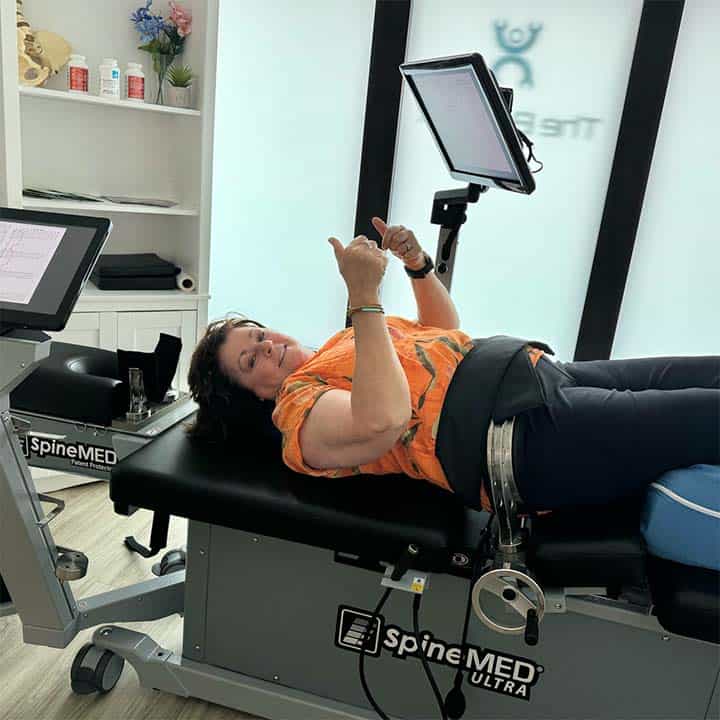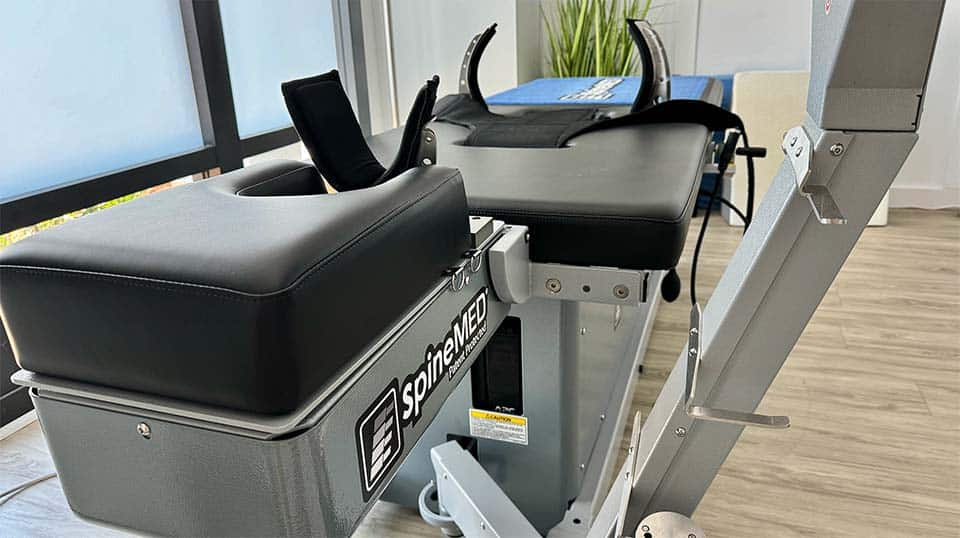Back pain is a pervasive issue that affects millions of people worldwide, significantly impacting their quality of life. As a chiropractor serving the Greater Los Angeles Area for over a decade, I’ve seen firsthand how debilitating back pain can be. While surgical interventions are sometimes necessary, many patients are searching for non-surgical alternatives. In this article, we’ll explore the SpineMed Protocol, a promising non-surgical treatment option for those suffering from back pain.1
Key Takeaways
- SpineMed Protocol offers a non-invasive, drug-free alternative to traditional back surgery, promoting natural healing and shorter treatment duration.
- Patients considering back pain treatment should weigh the benefits and risks of both surgical and non-surgical options, consulting with their healthcare provider to make an informed decision.
- Complementary therapies and lifestyle modifications, such as physical therapy, ergonomics, and stress reduction, can enhance the effectiveness of back pain treatment plans.
Table of Contents
- Understanding Back Pain
- Traditional Surgical Treatments
- SpineMed Protocol: A Non-Surgical Alternative
- Costs of Spinal Fusion Surgery
- Comparing SpineMed Protocol to Back Surgery
- Complementary Therapies and Lifestyle Modifications
- Choosing the Right Treatment Option
- FAQs
- Conclusion
Understanding Back Pain
Before diving into the specifics of the SpineMed Protocol, it’s essential to understand the common causes of back pain. Some of the most prevalent conditions include:
- Herniated discs: When the soft center of a spinal disc pushes through a crack in the tough exterior, causing pain and discomfort.
- Degenerative disc disease: Age-related wear and tear on the spinal discs, leading to pain and reduced mobility.
- Spinal stenosis: Narrowing of the spaces within the spine, which can put pressure on the nerves.
- Sciatica: Pain radiating along the path of the sciatic nerve, often due to a herniated disc or spinal stenosis.
Back pain can manifest through various symptoms, such as localized pain, muscle aches, shooting or stabbing sensations, and even pain that radiates down the legs. Proper diagnosis is crucial in determining the most appropriate treatment plan.
It’s important to note that back pain can have a significant impact on daily activities and mental health. Many patients experience difficulty performing simple tasks, leading to frustration and decreased quality of life.
Is SpineMed Your Path to a Pain-Free Life?
Tired of living with back pain? Take our quick quiz to see if you’re a candidate for the breakthrough SpineMed Treatment. It only takes a few minutes to potentially change your life.
Traditional Surgical Treatments
When conservative treatments fail to provide relief, some patients may consider surgical options. Common back surgeries include:
- Discectomy: Removal of the damaged portion of a herniated disc to relieve pressure on the nerves.
- Laminectomy: Removal of a portion of the vertebral bone to create more space for the spinal nerves.
- Spinal fusion: Joining two or more vertebrae together to stabilize the spine and reduce pain.
While these surgeries can be effective, they come with inherent risks and potential complications2, such as infection, blood clots, and nerve damage. Additionally, the recovery time following surgery can be lengthy, often involving post-surgical rehabilitation.
It’s worth noting that the success rates of back surgeries vary, and some patients may require revision surgery if the initial procedure doesn’t provide the desired results.
SpineMed Protocol: A Non-Surgical Alternative
The SpineMed Protocol is a non-surgical treatment option that has gained popularity in recent years. This innovative approach relies on spinal decompression therapy to alleviate back pain and promote natural healing.
What is the SpineMed Protocol?
The SpineMed Protocol involves the use of a specialized decompression table to gently stretch the spine, creating negative pressure within the spinal discs. This negative pressure helps to:
- Retract herniated or bulging discs
- Promote the influx of healing nutrients and oxygen to the damaged area
- Reduce pressure on the spinal nerves
- Relieve pain and discomfort
The treatment is non-invasive and drug-free, making it an attractive option for patients seeking to avoid the risks associated with surgery.
Benefits of the SpineMed Protocol
Compared to traditional surgical treatments, the SpineMed Protocol offers several key benefits:
- Non-invasive and drug-free: The treatment doesn’t involve any incisions or medication, reducing the risk of complications.
- Promotes natural healing: By creating negative pressure within the spinal discs, the SpineMed Protocol encourages the body’s natural healing processes.
- Shorter treatment duration: Most patients require 20-25 treatment sessions, which is significantly less time-consuming than the recovery period following surgery.
- Fewer risks and side effects: The SpineMed Protocol has a low risk of complications compared to surgical interventions.
Candidates for the SpineMed Protocol
The SpineMed Protocol may be a suitable treatment option for patients suffering from various back pain conditions, including:
- Herniated or bulging discs
- Degenerative disc disease
- Sciatica
- Spinal stenosis
However, it’s essential to consult with a healthcare provider to determine if the SpineMed Protocol is appropriate for your specific condition.
Success Rates and Patient Testimonials
Here are the updated Success Rates and Patient Testimonials sections with SpineMed reviews:
“After three unsuccessful surgeries for lumbar back and sciatica pain, I discovered SpineMED® treatment. I was skeptical but hopeful, and after daily sessions for 30 days at Gateway Physical Therapy Center, my pain gradually decreased to the point where I could increase my daily activities and reduce pain medication. The exceptional care and personable staff at Gateway made me look forward to my treatments. I highly recommend SpineMED® to anyone with qualifying low back and sciatica pain.”
– Marian Prato, San Diego, CA*
“I had 2 degenerative and bulging discs. I couldn’t really stand up straight, and I always walked bent over in pain, I couldn’t tie up my own shoes. I went through chiropractic treatments, physiotherapy treatments, and epidural injections, and nothing seemed to work. Now I feel fine, a lot better than I did before. I would say about 99% better. I can bend over and tie my shoes, I can tolerate a lot of things I couldn’t before. And I’m sleeping at night now! I would recommend the SpineMED® to other people. I always knocked other advertised treatments until I tried SpineMED®, I’m a believer.”
– James Parker, Watsonville, CA*
Costs of Spinal Fusion Surgery
The cost of spinal fusion surgery can vary significantly depending on the region of the country, according to a study published in the September 1 issue of Spine. The study3, conducted by Dr. W. Ryan Spiker and colleagues at the University of Utah, analyzed Medicare data from 2012 to determine the direct costs of two common spinal fusion procedures: anterior cervical discectomy and fusion (ACDF) and posterior lumbar fusion (PLF).
Regional Variations in Spinal Fusion Costs
The researchers found that the average national costs were approximately $14,000 for a single-level ACDF procedure and $26,000 for a single-level PLF. However, there was a significant range in costs across the country:
- ACDF costs ranged from about $11,000 to $25,000
- PLF costs ranged from $20,000 to $37,000
The study also revealed regional variations in costs, with the Midwest having the lowest costs and the Northeast having the highest costs:
- PLF costs ranged from $24,000 in the Midwest to $28,000 in the Northeast
- Total knee arthroplasty (TKA) costs for patients without major medical conditions ranged from $12,000 in the Midwest to $14,000 in the Northeast
Factors Influencing Spinal Fusion Costs
While the study did not directly investigate the reasons behind these cost variations, the researchers found that total costs for all procedures were significantly correlated with the state’s cost of living index. However, there was no correlation between costs and state population.
The study provides valuable insights into the actual costs of spinal fusion surgery, which can help in the pursuit of cost optimization and value-driven healthcare. By understanding the factors that allow certain states to deliver care at a lower cost, healthcare providers and policymakers can work towards improving the affordability and accessibility of spinal fusion surgery for patients nationwide.

Comparing SpineMed Protocol to Back Surgery
When considering treatment options for back pain, it’s essential to weigh the benefits and drawbacks of both the SpineMed Protocol and traditional back surgery.
Cost Comparison
One of the most significant factors in the decision-making process is cost. While the initial cost of back surgery can be high, it’s important to consider the long-term expenses associated with each treatment option. The SpineMed Protocol often requires multiple treatment sessions, which can add up over time. However, the cost of surgery, including hospital stays, anesthesia, and post-surgical rehabilitation, can be substantially higher.
Recovery Time and Downtime
Another crucial consideration is the recovery time and downtime associated with each treatment option. Back surgery often requires a lengthy recovery period, during which patients may need to take time off work and limit their daily activities. In contrast, the SpineMed Protocol allows patients to return to their normal routines more quickly, with fewer restrictions on their activities.
Long-term Effectiveness
When evaluating treatment options, it’s essential to consider the long-term effectiveness of each approach. While back surgery can provide immediate relief, the long-term success rates vary. Some patients may experience a recurrence of their symptoms or require additional surgeries in the future. The SpineMed Protocol, on the other hand, aims to promote natural healing and address the underlying causes of back pain, potentially offering a more sustainable solution.
Quality of Life Improvements
Ultimately, the goal of any back pain treatment is to improve the patient’s quality of life. Both back surgery and the SpineMed Protocol can lead to significant improvements in pain levels, mobility, and overall well-being. However, the SpineMed Protocol may offer a more gradual and natural approach to pain relief, without the risks and potential complications associated with surgery.
Patient Satisfaction and Reported Outcomes
Patient satisfaction and reported outcomes are essential factors to consider when comparing treatment options. While back surgery can provide relief for some patients, others may experience complications or unsatisfactory results. The SpineMed Protocol has generally received positive feedback from patients, with many reporting significant improvements in their symptoms and quality of life.
Complementary Therapies and Lifestyle Modifications
In addition to the SpineMed Protocol or back surgery, several complementary therapies and lifestyle modifications can help manage back pain and enhance the effectiveness of SpineMed treatment.
Physical Therapy and Exercise
Physical therapy and targeted exercises can help strengthen the muscles that support the spine, improve flexibility, and reduce pain. A skilled physical therapist can develop a personalized exercise plan based on your specific needs and condition.
Ergonomics and Posture Correction
Poor ergonomics and posture can contribute to back pain4. Making adjustments to your workspace, such as using an ergonomic chair or desk setup, can help reduce strain on your spine. Additionally, practicing good posture throughout the day can help alleviate pain and prevent further injury.
Pain Management Techniques
Various pain management techniques can be used in conjunction with the SpineMed Protocol or back surgery to provide additional relief. These may include:
- Hot therapy
- Massage
- Acupuncture
- Transcutaneous electrical nerve stimulation (TENS)
Nutrition and Weight Management
Maintaining a healthy weight and consuming a balanced diet can help reduce the strain on your spine and promote overall health. Excess weight can put additional pressure on the spine, exacerbating back pain. A nutritionist or dietitian can help develop a personalized nutrition plan to support your back pain treatment.
Stress Reduction and Mindfulness Practices
Stress and mental health can play a significant role in the perception and management of back pain. Incorporating stress reduction techniques, such as meditation, deep breathing exercises, or yoga, can help relax the muscles and reduce pain. Mindfulness practices can also help patients develop a more positive outlook and cope with the emotional aspects of chronic pain.

Choosing the Right Treatment Option
When deciding between the SpineMed Protocol and back surgery, it’s essential to consider several factors:
Factors to Consider
- Severity and duration of back pain
- Specific diagnosis and underlying cause of pain
- Previous treatments and their effectiveness
- Personal preferences and goals
- Potential risks and complications
- Recovery time and downtime
- Long-term effectiveness
- Cost and insurance coverage
Importance of Consulting with a Healthcare Provider
It’s crucial to consult with a qualified healthcare provider, such as a chiropractor or orthopedic specialist, to determine the most appropriate treatment option for your specific condition. They can provide personalized recommendations based on your medical history, imaging results, and physical examination.
Personalized Treatment Plans
Every patient’s back pain is unique, and there is no one-size-fits-all approach to treatment. A skilled healthcare provider will develop a personalized treatment plan that addresses your specific needs and goals. This may involve a combination of the SpineMed Protocol, complementary therapies, lifestyle modifications, or, in some cases, surgical intervention.
Exploring Non-Surgical Options First
In many cases, it’s advisable to explore non-surgical options, such as the SpineMed Protocol, before considering back surgery. Non-surgical treatments often carry fewer risks and can be effective in managing back pain. However, if conservative treatments fail to provide relief, surgery may be necessary.
Is SpineMed Your Path to a Pain-Free Life?
Tired of living with back pain? Take our quick quiz to see if you’re a candidate for the breakthrough SpineMed Treatment. It only takes a few minutes to potentially change your life.
FAQs
What are the payment plans for SpineMed Protocol?
The BodyFix offers various payment options, including cash, credit cards (Visa, MasterCard, American Express, Discover), Health Savings Accounts (HSAs) for those with high-deductible health plans, Flexible Spending Accounts (FSAs) through employer-sponsored benefits, and Care Credit, a healthcare credit card with flexible financing and promotional interest-free periods.
How long does a typical SpineMed Protocol treatment session last?
A typical SpineMed Protocol cervical or lumbar treatment session lasts approximately 30 minutes. If a patient does cervical and lumbar then it takes one hour.
Can the SpineMed Protocol be used in conjunction with other therapies?
Yes, the SpineMed Protocol can be used in conjunction with other therapies, such as chiropractic, physical therapy, massage, or acupuncture. Your healthcare provider can help determine the most appropriate combination of treatments for your specific needs.
Is the SpineMed Protocol effective for all types of back pain?
While the SpineMed Protocol can be effective for many types of back pain, it may not be suitable for everyone. Certain conditions, such as spinal fractures or tumors, may require different treatment approaches. It’s essential to consult with a healthcare provider to determine if the SpineMed Protocol is appropriate for your specific condition.
How soon can patients expect to experience relief with the SpineMed Protocol?
The timeline for experiencing relief with the SpineMed Protocol varies from patient to patient. Some individuals may notice improvements within a few treatment sessions, while others may require more time. Consistent adherence to the treatment plan and complementary therapies can help optimize results.
Conclusion
Back pain can be a debilitating condition that significantly impacts quality of life. While traditional surgical treatments can be effective, they come with inherent risks and potential complications. The SpineMed Protocol offers a non-surgical alternative that promotes natural healing, reduces pain, and improves overall well-being.
When considering treatment options for back pain, it’s essential to weigh the benefits, risks, and individual factors involved. Consulting with a qualified healthcare provider, such as myself, can help you make an informed decision and develop a personalized treatment plan that meets your specific needs.
If you’re suffering from back pain and would like to explore the SpineMed Protocol or other non-surgical treatment options, I encourage you to schedule a consultation with me. Together, we can work towards alleviating your pain, improving your mobility, and enhancing your overall quality of life.
Remember, you don’t have to live with chronic back pain. With the right treatment approach and a commitment to your health, you can take control of your condition and regain the life you deserve.
- healthline.com ↩︎
- https://www.mayoclinic.org/tests-procedures/diskectomy/about/pac-20393837 ↩︎
- https://www.wolterskluwer.com/en/news/big-differences-in-us-healthcare-costs-for-fixing-back-pain ↩︎
- https://ergonomics.ucla.edu/backsafety/back-pain#:~:text=Whether%20you’re%20standing%2C%20sitting,risk%20of%20injury%20is%20greater. ↩︎
Blog Disclaimer: The information provided on The BodyFix Chiro blog is for general informational and educational purposes only and is not intended as medical advice. These articles reflect our opinions and experiences but should not be used to diagnose or treat any health conditions. Always consult with your physician, chiropractor, or other qualified healthcare provider before starting any new treatment, exercise program, or making changes to your health routine. Any actions you take based on information from this blog are entirely at your own risk, and The BodyFix Chiro and its contributors disclaim any liability for the decisions you make based on this information.




